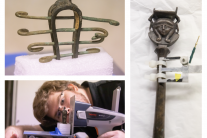The University of Louisiana at Lafayette has taken its place in the top level of the nation’s research institutions
LAC Inspects Egyptian Artifacts
Tue, 09/20/2022 - 3:52pmThe Louisiana Accelerator Center recently was engaged in a study of ancient Egyptian artifacts (712-332 BC) that are part of the Museo Egizio's collection, based in Turin, Italy. The New Orleans Museum of Art hosted the Queen Nefertari’s Egypt exhibition this year, organized in collaboration with StArt and Museo Egizio, which is the oldest museum in the world dedicated to Egyptian antiquities. Several bronze objects from the exhibition, such as the handle and the upper part of a sistrum (sacred musical instrument of ancient Egypt), were brought to UL Lafayette for investigations.
Particle-Induced X-ray Emission (PIXE) was used on several areas of the artifacts to resolve their elemental composition down to very fine levels (part per million). This exact elemental analysis, capable to quantify major, minor, and trace elements, is used to determine location- and time-dependent characteristics that may add to the objects' history and traceability. X-ray Fluorescence (XRF) was run in parallel, for a base-line comparison. As museums often have access to the second technique, which is not as accurate, the comparison helps establish its general validity. The contribution of the Louisiana Accelerator Center to this societally impactful and global project was possible due to its technological capabilities supported by the university and the state of Louisiana.

